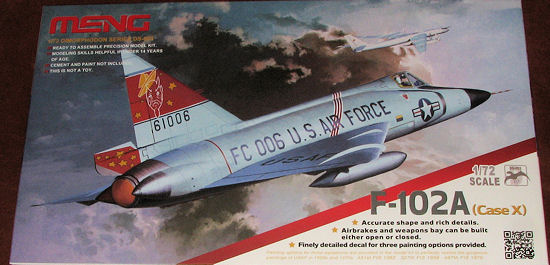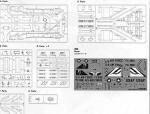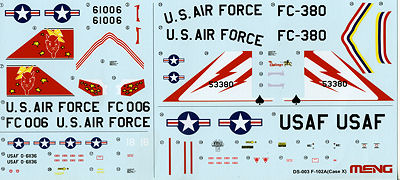
| KIT #: | DS-003 |
| PRICE: | $39.95 SRP |
| DECALS: | Three options |
| REVIEWER: | Scott Van Aken |
| NOTES: | New tool kit |

| HISTORY |
The F-102 was developed from the XF-92A delta wing research aircraft of the late 1940s. The Air Force took a new approach in putting out the request for proposals for an operational interceptor, considering both the aircraft and armament together in what became known as a "weapon system". The RFP for Project MX-1554 went out 18 June 1950, and in January 1951 six manufacturers responded, of which Convair, Lockheed, and Republic were chosen to proceed with design. Three of these projects were too expensive, and in November, only Convair was allowed to continue with its Model 8-80, an interim project using the less-powerful Westinghouse J40 turbojet in lieu of the Wright J67 which was still in development.
The YF-102 made its first flight on 24 October 1953, but was lost to an accident nine days later. The second aircraft flew on 11 January 1954, confirming a dismal performance: Approximately 812 mph, while supersonic, it was far below the requirements. The problem was solved by the use of the area rule, which entailed narrowing the aircraft down in the mid-section, moving the cockpit and intakes back further, blending the outer contours of the intake duct, lengthening the nose and adding two fairings on either side of the engine nozzle, resulting in the new "'YF-102A design'". The new design was more than twice as fast as the non-area ruled design. The "'YF-102A'", however was not exactly the same as the production F-102A design in that its nose was considerably longer than the "'F-102A.'
Somewhere along the way, the Wright J-67 was cancelled, and the J-40 was replaced with a Pratt & Whitney J-57.
The production F-102A had the Hughes MG-3 fire control system, later upgraded in service to the MG-10. It had a three-segment internal weapons bay under the fuselage for air-to-air missiles. Initial armament was three pairs of GAR-1 Falcon missiles, a mix of infrared and semi-active radar homing. The doors of the two forward bays each had tubes for 12 x 2.75 in FFAR rockets (for a total of 24). The F-102 was later upgraded to allow the carriage of a GAR-11 Nuclear Falcon missiles in the center bay. The larger size of this weapon required redesigned center bay doors with no rocket tubes. Plans were considered to fit the MB-1 Genie nuclear rocket to the design, but it was never adopted.
Because of the changes that had to be made in redesigning the aircraft with the area rule in mind, the ambitious plan to produce the production aircraft on the prototype tooling had to be abandoned; two-thirds of the 60,000+ pieces of tooling had to be scrapped or heavily modified.
To train F-102A pilots, the TF-102A trainer was developed, with 111 eventually manufactured. The aircraft was fitted with a side-by-side cockpit to facilitate ease of pilot training. This required a redesign of the cockpit and nose incorporating a set of vortex generators on the top of the cockpit to prevent flow separation under certain circumstances, and repositioning of the intake ducts. Despite the many changes, the aircraft was combat-capable, although this variant was predictably slower, only reaching subsonic speeds in level flight.
The F-102's direct successor was the related F-106 Delta Dart, which was originally designated YF-102B. The design underwent so many aerodynamic changes including a larger J-75 turbojet and a variable-geometry inlet design that it essentially became an entirely new plane.
The F-102A provided years of service in Fighter Interceptor Squadrons with the USAF and ANG. It only fired its weapons in combat during ground attack missions in Vietnam in the mid 1960s using its FFAR rockets, which were, by all accounts, quite a devastating weapon if on the receiving end.
| THE KIT |
 For many years 1/72 jet modelers have been hoping for new tool century series kits. Sure, Hasegawa did them all as part of their initial batch of kits in the late 1960s and early 1970s, but those kits were pretty basic in terms of both internal and external detailing. Over the years, there have been better F-100s, F-104s, and F-105s, but the delta wing aircraft have not been forthcoming. This had now changed with the release of the new Meng F-102A with the Case X wing.
For many years 1/72 jet modelers have been hoping for new tool century series kits. Sure, Hasegawa did them all as part of their initial batch of kits in the late 1960s and early 1970s, but those kits were pretty basic in terms of both internal and external detailing. Over the years, there have been better F-100s, F-104s, and F-105s, but the delta wing aircraft have not been forthcoming. This had now changed with the release of the new Meng F-102A with the Case X wing.
This new kit does not come cheap, but with the cost of the ancient Hasegawa kits constantly rising, perhaps this cost is worth bearing. If you have ever seen a Meng kit, you are aware that the detailing is actually quite good. Nicely engraved detailing is standard with the engraved 'rivet' detailing pretty much limited to those panels that are normally removed. The detailing is not quite as fine as you would see on a modern Hasegawa or Cyber-hobby kit, but not all that large, either. I can deal with it. You get a three piece bang seat without harness, a cockpit tub with molded on rudder pedals, an instrument panel and control stick for the cockpit. Detailing on the instrument panel and side consoles is raised with a decal for the instrument panel if you want to use it. While on the subject of the cockpit, there is a separate canopy and windscreen. You can pose the canopy open as it comes with the proper mechanism.
You get nicely done wheel wells with detail and a realistic depth. Landing gear are also well formed with separate wheels and oleo scissors for all three gear. The speed brake can be positioned open if you wish, though normally, it was closed. There is a nicely done intake and while there is no trunking, the tailpipe assembly should prevent any see-through situation. The wing tips are separate so that later boxings can portray the Case XX wing. To do a TF-102, several new sprues will have to be done, so it remains to be seen if this will be produced.
The weapons bay can be molded closed if you wish, or open. Falcon missiles are provided and these can be displayed either with the racks fully extended or retracted into the bay. For the later versions of the F-102, a seeker head is provided for in front of the cockpit. A pair of wing tanks rounds things off. These tanks have small fins on them, something I do not recall seeing in previous kits. If they do not belong, they can easily be sanded away.
 Instructions are a nice booklet that includes Gunze paint references.This kit has the earlier Case X wing. The Case XX wing has a decided downward curve on the wing tip. The Case XX wing was installed starting with aircraft 56-1317 and not retrofitted to earlier planes. Unlike previous F-102A kits, Meng has chosen options that are all correct for this earlier wing. There are markings for three aircraft and the painting and markings guide are in full color as a fold out at the end of the instructions. The box art plane of the 431 FIS in 1962 is in overall ADC Grey with a black radome and black anti-glare and intake walk areas. These black areas will need to be painted. The other ADC Grey
Instructions are a nice booklet that includes Gunze paint references.This kit has the earlier Case X wing. The Case XX wing has a decided downward curve on the wing tip. The Case XX wing was installed starting with aircraft 56-1317 and not retrofitted to earlier planes. Unlike previous F-102A kits, Meng has chosen options that are all correct for this earlier wing. There are markings for three aircraft and the painting and markings guide are in full color as a fold out at the end of the instructions. The box art plane of the 431 FIS in 1962 is in overall ADC Grey with a black radome and black anti-glare and intake walk areas. These black areas will need to be painted. The other ADC Grey plane is from the 327th FIS in 1958 and has a great white tail with red lightning bolts on it. The third option, which gets the seeker head, is a camouflaged version from the 497th FIS in 1970. I am thinking that this unit flew in Vietnam, hence the camo scheme. The rather large decal sheet is very nicely done and quite in register. There have been aftermarket markings done for this aircraft so you may have some options in that regime if none of the kit markings strike your fancy.
plane is from the 327th FIS in 1958 and has a great white tail with red lightning bolts on it. The third option, which gets the seeker head, is a camouflaged version from the 497th FIS in 1970. I am thinking that this unit flew in Vietnam, hence the camo scheme. The rather large decal sheet is very nicely done and quite in register. There have been aftermarket markings done for this aircraft so you may have some options in that regime if none of the kit markings strike your fancy.
| CONCLUSIONS |
So there you have it. The new tool F-102A that many have been hoping for is now available. It is not cheap so you should be ready to pay the piper as they say. But from what I see in the box, it is well worth the expenditure and will make a lot of Cold War interceptor fans very happy.
| REFERENCES |
December 2012
Thanks to your editor for picking up the preview kit and paying retail.
If you would like your product reviewed fairly and fairly quickly, please contactthe editor or see other details in the